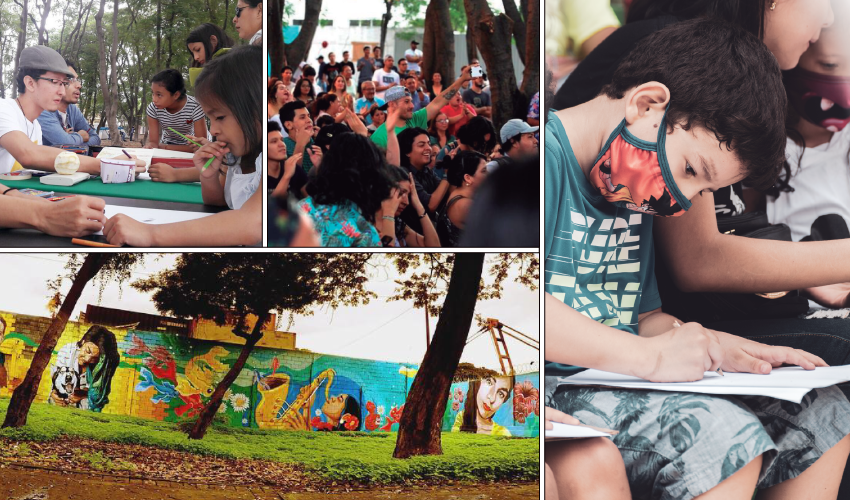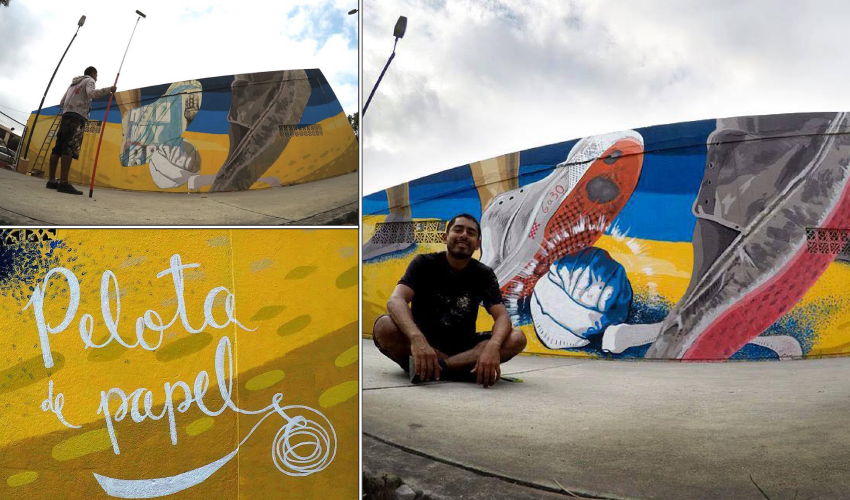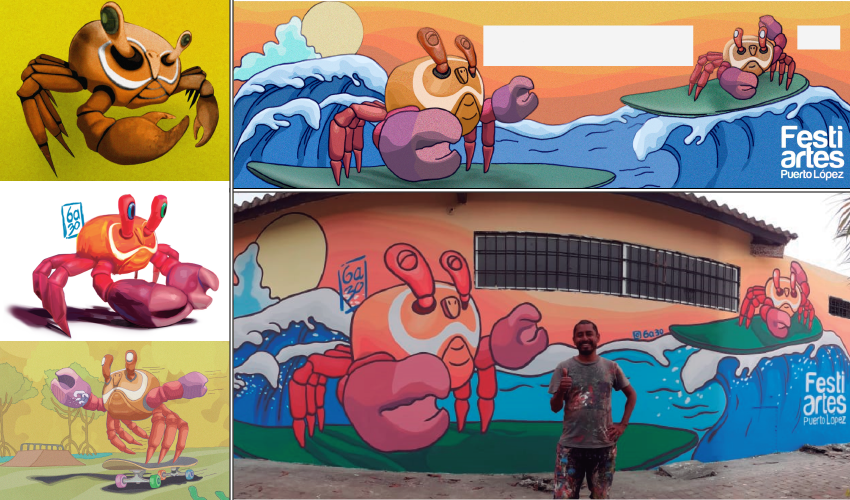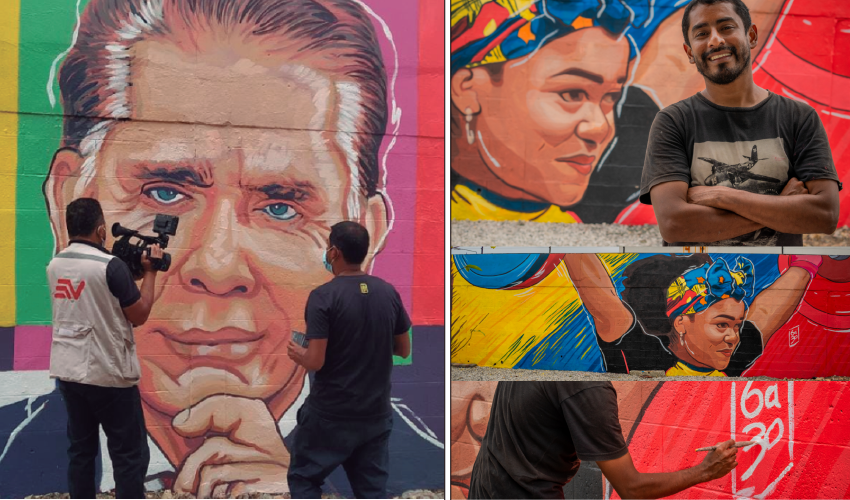
Gabriel Peña is an urban artist born in Guayaquil. He graduated from the Escuela Superior Politécnica del Litoral with a degree in Graphic Design and Audiovisual Production. For the past six years, he has been expressing his art through muralism, with his characteristic figurative style, in various sectors of the city.
Currently, his murals can be seen in the southern part of Guayaquil, in neighborhoods such as Pradera 3, Pradera 2, Pradera 1, Los Almendros, Tulipanes, and Cristo del Consuelo; and in the north, in areas like Urbanor, La Garzota, Sauces, and Mucho Lote.
What is your process for creating a mural?
I analyze the location to find a theme that contributes to the area; then I look at the wall's dimensions and play with elements that fit those dimensions. After that, I start sketching the ideas on a small scale until I have a nearly final, colored piece of art. Finally, I transfer the artwork to a large scale and begin painting with brushes and acrylic paint.
How do you choose the location and the artwork you create there?
I often like to paint on visible walls where I can paint my crab character in the city of Guayaquil. So, I find out who owns the wall to avoid any issues when I intervene. I also get called to paint walls and improve the aesthetics of a place or a commercial establishment.
Once a year, I look to collaborate with or contribute to a foundation or community by creating a participatory mural with a theme that depends on the location. I try to do this without any profit motive as a way to give back for my artistic achievements. Currently, I'm painting in my neighborhood as part of a project called Bosque de Colores. I started the plan with the help of my family, neighborhood friends, and artist friends.
Could you tell us about your Bosque de Colores project?
Bosque de Colores is a festival with a magical and vibrant essence that combines various environments. The intention is to perfectly fuse nature, culture, art, theater, music, food, and positive energy. The idea for this festival began three years ago, inspired by an artistic neighborhood called Loma San Jerónimo, declared a cultural heritage site in Asunción, Paraguay. From this experience, I developed a desire to improve Bosque de la Pradera 3 through art.
As the creator and director of the project, I saw a great opportunity to create a tourist and interactive space in the place where I grew up. For many years, I had the idea of creating something that would connect with society, promoting art and urban talents in the southern part of the city, since most activities were concentrated in the center and the north.
This project in the forest has planted a cultural seed for other projects that will benefit our city in the future. Additionally, it reduces crime and drug use because there are now new, interesting, and different initiatives that invite everyone to join a positive cause, filled with learning, culture, friendship, and respect.
The festival has had three editions, each filled with the participation and joy of various Guayaquil artists. These include musicians, muralists, illustrators, poets, storytellers, athletes, jugglers, and also the group of explorers, "Scouts #76." The third edition of the festival was aimed at children.

How do you believe art contributes to improving a sector?
Speaking generally about art, it significantly contributes to the sector in many ways: through culture, tourism, and the economy. This way, the project helps give an identity to a sector and can spark interest in children, who are the future. When it comes to the murals that have been created in the sector, they contribute by creating a vast outdoor art gallery.
What is your most notable work to date?
Paper Ball has been my favorite piece to paint because of its entire context. I felt a lot of anger, frustration, and energy while painting this mural, which represents that no one can take away your dreams when you want to do something with all your heart.
The mural is a reminder of childhood when, with friends, we didn't have a soccer ball, so we made a ball out of paper. Despite having worn-out shoes, no one could take away our desire to play, score goals, or be the coolest goalkeeper. In this way, we shone like the top players of the moment.
What inspired me to paint Paper Ball was that some people wanted to take over my Bosque de Colores project. However, with the support of my family and friends, we pushed the project forward independently, delivering the message that no one can take away your dreams when you want to do something with all your heart.
The mural was created with a budget of $80, which led me to use very inexpensive materials. Additionally, I didn’t have scaffolding to paint at that height, but as an urban artist, I managed with extenders and rollers; sometimes, I climbed to the lowest part of the wall to reach the roof and paint from above. It was thrilling because I needed to deliver the message and enjoyed every aspect of the work. I used a color palette based on the three colors of the Ecuadorian flag. In the end, I achieved the result I expected, and although the mural is no longer there today because it's ephemeral, the message remains.
What other work are you currently involved in besides muralism?
I am heavily focused on my Crab illustration. I've been working on this illustration since 2015, but it has evolved, with the character now being more stylized, and I’ve also drawn it in various actions that represent my experiences.
I want to continue developing the character that has been painted in several places around Guayaquil. I’m also working on creating a comic strip featuring the Guayaquilean crab. I’ve released crab-themed t-shirts, stickers, and paintings for sale.

Why did you choose the crab as your emblem?
I started drawing it because I love eating crabs, but over time, the character evolved until I found an illustration that represented it as a symbol of our city, Guayaquil, and its mangroves. However, I don't eat as many crabs nowadays.
Why did you choose journalist Alfonso Espinoza as part of your most recent work?
I chose to paint a mural of Don Alfonso as a tribute to an Ecuadorian figure who holds a Guinness World Record and serves as an example for our community. The mural had such a wide reach that I was deeply moved when Don Alfonso personally thanked me on Ecuavisa's news program.
Recently, I also created a mural in tribute to Neisi Dajomes. I believe it’s well-deserved because she brought us the gold medal at the Tokyo 2021 Olympics. She raised our country’s profile, and I consider her an example of courage and strength that will remain in our hearts.

31/08/2021




